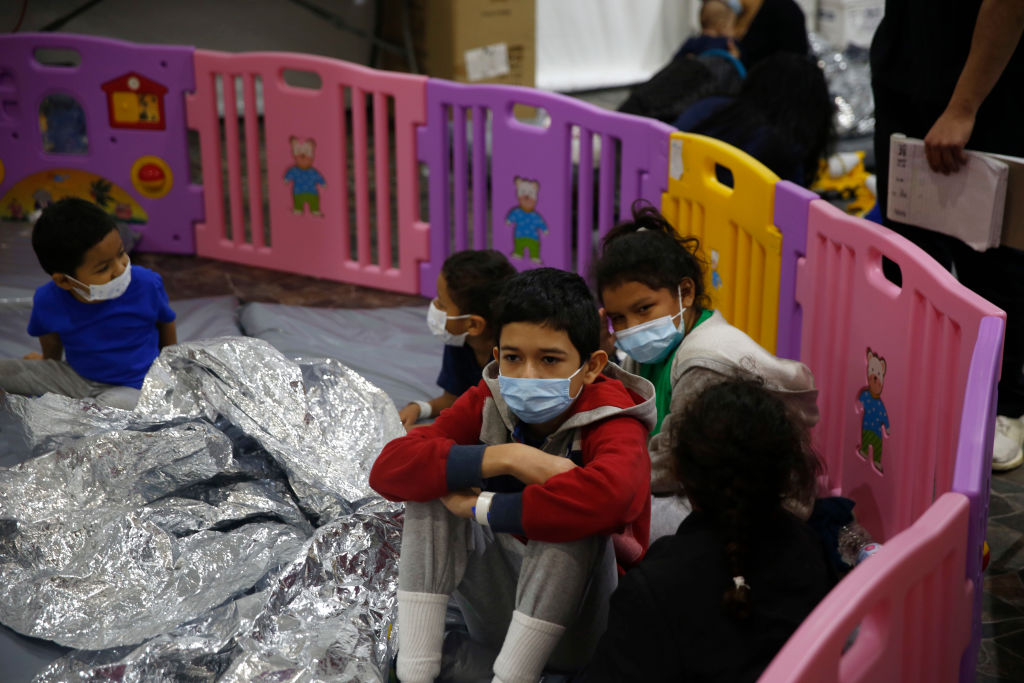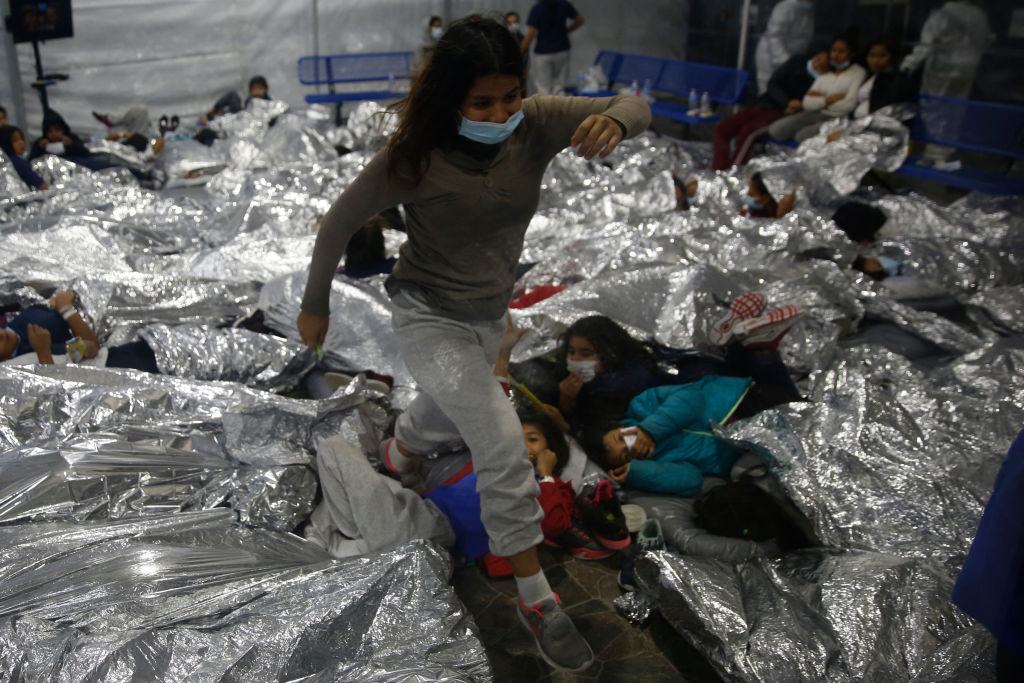
Heavy politicization of the U.S.-Mexico border has followed as thousands of unaccompanied migrant children have presented themselves to government officials at the border, making it more challenging to distinguish between fact and political narrative.
For the Biden Administration, the increase in the numbers of people arriving at the U.S.-Mexico border, particularly the influx of children showing up alone, has created a logistical, political and ethical challenge. The Department of Homeland Security (DHS) had directed FEMA to aid with processing and transferring minors who are arriving alone in the hopes of uniting with relatives and loved ones already in the United States. Meanwhile most migrants who are single adults or traveling in family units are being “expelled” under Title 42, a rule put in place during the Trump Administration that allows the government to immediately turn away migrants who show up at the border, even if they wish to make an asylum claim, because of the risks posed by COVID-19.
Still, DHS Secretary Alejandro Mayorkas and other high-ranking government officials, including President Joe Biden have called the increase in unaccompanied minors a “challenge,” while Republican lawmakers have been quick to call the situation a “crisis” and to place blame on Biden’s changes to former President Trump’s hardline immigration policies for what we are seeing today.
No matter the increased politicization of the U.S.-Mexico border, data shows that for a variety of reasons the number of unaccompanied migrant children needing to be processed into the U.S. and the number of people requiring shelter on the Mexican side of the border because of Title 42, has put strain on what some have called an already broken system. “Clearly the fact that the Administration thought to activate FEMA reflects that this is an emergency,” says Krish O’Mara Vignarajah, president and CEO of the Lutheran Immigration and Refugee Service, a nonprofit that assists in providing temporary foster care for unaccompanied migrant children. “I’ll leave it to politicians to wordsmith how they want to frame it…the bottom line is that we need to address an emergency situation of unaccompanied children coming across the border who have already been through so much and need our help now.”
On Friday, The New York Times reported that more than 18,700 unaccompanied migrant children were detained at the U.S.-Mexico border in March, nearly double the about 9,400 who were detained in February, according to documents obtained by the newspaper. Official government figures are expected to be released next week.
Border Patrol agents near Penitas, Texas, on March 28 encountered a group of 99 people trying to enter the U.S. illegally on Sunday. Among them were 20 children who were traveling without their parents, and six of them were under the age of 13, according to U.S. Customs and Border Protection (CBP). The next day near La Grulla, Texas, Border Patrol agents encountered 24 more unaccompanied migrant children.

What’s happening with unaccompanied minors at the U.S.-Mexico border?
Between March to November 2020, most unaccompanied minors arriving at the U.S.-Mexico border were turned away because of Title 42. More than 15,800 minors were expelled in 2020, according to the Migration Policy Institute (MPI), a nonpartisan research institution. Many stayed in Mexico, while another one of the Trump Administration’s policies, the Migrant Protection Protocols (MPP), also forced thousands of people to wait out their asylum claims south of the border.
In January, CBP announced it was seeing an increase in “enforcement encounters,” which is defined by CBP as instances when a person is expelled or apprehended. More than 78,000 enforcement encounters took place in January, a 6% increase since December 2020, according to the agency, which includes single adults, family units and children arriving alone. That number increased to more than 100,000 in February. The data publicly available by CBP includes the number of expulsions and apprehensions, but not the specific number of people encountered—for example, a single person can be expelled multiple times, which may contribute to the high number of encounters at the border. During most of 2020, apprehensions at the southern border remained low, in part because of the COVID-19 pandemic. But beginning April of 2020, overall numbers began to increase again after a low of about 17,000 enforcement encounters that month.
At the start of the Biden Administration, DHS decided that it would no longer expel unaccompanied migrant children under Title 42 if they were from a country other than Mexico (single adults and family units would continue to be expelled except in cases where Mexico’s shelter capacity was full). The vast majority of unaccompanied children are from Central America, according to MPI. Very quickly, the number of unaccompanied children needing to be processed into the U.S. increased—some were newly arrived and others had been waiting after being expelled to Mexico by the Trump Administration. The increase of unaccompanied minors soon overwhelmed the U.S. shelter capacity that had been reduced during the Trump presidency because of the low number of unaccompanied migrant children processed into the U.S. and to allow for social distancing.
White House officials told reporters during a press briefing on March 18 that they were unaware of whether parents who migrated to the U.S.-Mexico border with their children were deciding to have their children present themselves to border officials alone knowing that family units were being expelled under Title 42, but anecdotally some parents have told reporters about making such a decision. Karina Breceda, coordinator at the San Juan Apóstol Shelter for migrant women in Ciudad Juárez, tells TIME she has seen families make that decision. “The crisis isn’t with the amount of people coming, the crisis is in how we’re responding to it,” Breceda says. “It’s a humanitarian crisis. The way we’re responding to people, their personhood and their dignity, that’s the issue, not the amount of people.”
Tom Wong, associate professor of political science at the University of San Diego, told reporters during a press conference on March 26 there is not yet enough data to determine if Biden policies are what have caused the increases in apprehensions at the border. He hypothesizes that the increase could be the result of human smugglers taking advantage of changes in administrations. “It could have been Trump to Biden, Trump to—pick your candidate,” he told reporters. “What we know is that human smugglers, with a multibillion dollar industry, they tend to exploit change.” Smugglers will promise that “this is the time that you can make it into the country,” he said. “Regardless of whether or not it is true.”
Important to note, Wong said, is seasonal patterns in migration. Historically, unauthorized migration to the U.S.-Mexico border increases beginning in January, but then typically drops around June or July, when the weather becomes too hot to travel safely. Apprehension so far this year reflects similar seasonal patterns. A senior Border Patrol official who agreed to speak to reporters on background on March 26 also added that he expects enforcement encounters to increase in the coming months, in line with the seasonal patterns the border sees every year.
On March 31, 451 children were apprehended by CBP, not including children who are from Mexico who will be sent back; 4,966 were in CBP custody, and 13,204 had been transferred to Health and Human Services (HHS), according to the most recent data available.
How is the Biden Administration responding?
In order to transfer children from CBP custody and into HHS custody as quickly as possible, the Biden Administration has built several makeshift facilities to house unaccompanied minors. On Wednesday, HHS announced it will open space for 500 children at the National Association of Christian Churches in Houston. The Houston site is the most recent out of more than nine to open throughout Texas and in San Diego.
Children are required to pass through DHS custody and into HHS custody in under 72 hours, but because of the high volume, many children are staying at CBP facilities longer. HHS has increased bed capacity to about 13,500, but “additional capacity is urgently needed to manage both enhanced COVID-19 mitigation strategies and the increasing numbers of [unaccompanied child] referrals from CBP,” according to HHS.
Journalists, who were previously barred from entering the new facilities, have recently been able to see the facility constructed in Donna, Texas, to temporarily house migrant children. According to reporters, the facility was overcrowded with children. In a statement to CBS News, DHS Secretary Mayorkas said the agency is working as quickly as possible to process the children out of the facility.
The Biden Administration has also begun steps to address the root causes of migration from Central America and is collaborating with the Mexican government to begin talks with Central American leaders. On March 24, the White House announced that Vice President Kamala Harris would be in charge of overseeing this effort. One of the first steps in that process was a Tuesday call between Harris and the President Alejandro Giammattei of Guatemala. “Vice President Harris and President Giammattei agreed to collaborate on promoting economic development, leveraging technology, strengthening climate resilience, and creating the conditions to expand opportunity for people in their home countries in order to address the root causes of migration to the United States,” the White House said in a public statement.
More Must-Reads From TIME
- The 100 Most Influential People of 2024
- The Revolution of Yulia Navalnaya
- 6 Compliments That Land Every Time
- What's the Deal With the Bitcoin Halving?
- If You're Dating Right Now , You're Brave: Column
- The AI That Could Heal a Divided Internet
- Fallout Is a Brilliant Model for the Future of Video Game Adaptations
- Want Weekly Recs on What to Watch, Read, and More? Sign Up for Worth Your Time
Write to Jasmine Aguilera at jasmine.aguilera@time.com